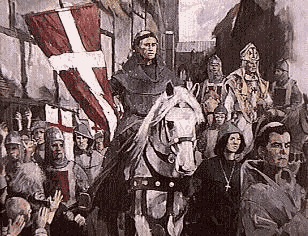|
GIRALDUS CAMBRENSIS OR GERALD OF WALES
Contents
Introduction
Part I
The Welsh
Their hospitality
and eating habits
How the Welsh
cut their hair, take care of their teeth and shave off their beards
The Welsh
love music and singing
Part II
Faults in the Welsh
Character
The Welsh
in battle
The Welsh
as landowners
The fostering
of sons
Geoffrey
of Monmouth
The Crusades and
Archbishop Baldwyn of Canterbury
Itinerary
of the journey
The aftermath
This treatise examines the writings of Giraldus Cambrensis or
Gerald of Wales. He was one of the earliest writers of social history as applied
to the Celtic nations of Britain. Trained as a cleric he began his literary career
with an account of the Norman conquest of Ireland, and followed this with his account
of life in what has now become Wales. His long journey accompanying the Archbishop
of Canterbury, Baldwyn, on a tour of Wales, gave rise to some shrewd observations
on the good and bad facets of the Welsh character. It is not clear which language
he used in his dealings with the common people. His religious speech would have been
either Latin or French, but it is not certain how much of his sermonising would have
been understood by the people he was trying to induce to take part in a crusade to
the Holy Land.
 Giraldus Cambrensis: also known
as Gerald of Wales or Gerald de Barri Giraldus Cambrensis: also known
as Gerald of Wales or Gerald de Barri
Life: (c.1147-1223)
He was elected Bishop of St David's in 1176, but when Henry II refused to confirm
his election, he withdrew to lecture at Paris. Later, appointed a royal chaplain,
in 1185 he accompanied Prince John to Ireland.
He wrote an account of Ireland's natural history and inhabitants, following this
with Expugnatio Hibernica (c.1189, History of the Conquest of Ireland). In
1188 he travelled through Wales to recruit soldiers for the Third Crusade, and wrote
up his observations in the Itinerarium Cambriae (1191, Itinerary of Wales).
Giraldus Cambrensis or Gerald of Wales was born at Manorbier in Pembrokeshire
around 1147 into a Norman-Welsh family. His father, Gerald de Windsor had married
Nest, the daughter of Rhys ap Tewdwr, Prince of Deheubarth; the family also claimed
a relationship with the family of The Lord Rhys (Rhys ap Gruffydd). Gerald was educated
in Paris; he served as an administrator of the see of St. David's and as a clerk
at the court of Henry II, accompanied Prince John to Ireland, and traveled with Archbishop
Baldwyn through Wales.
Gerald's writings reflect experiences gained on his travels as well as his knowledge
of the authorities on learning. Repeatedly rejected for the bishopric of his beloved
St. David's, Gerald pleaded not only his own cause, but that of St. David's as an
archbishopric, visiting Rome on three occasions in support of his claims. Failing
to be appointed to St. David's, Gerald maintained that it was the fear of the effect
that it would have on the national politics in Wales that prevented his appointment.
(The Pope was not too anxious to have a Welsh Church independent of Canterbury).
It was his prolific writing, particularly Itinerarium Cambriae (The Journey
Through Wales) and Descriptio Cambriae (Description of Wales) that were to
provide Wales with the only sources of many early Welsh history and folk tales.
Gerald travelled throughout Wales collecting stories, noting conversations and events
of the day, and penning his books. He was nominated in 1198 for a second time as
Bishop of St David's but, following his rejection by the Archbishop of Wales, Gerald
then campaigned for an independent archbishopric with himself in the post.
Though a Welsh churchman of the 12th century he wrote rather disparagingly of his
fellow countrymen in his book Itinerarium Cambriae about the journey he made
with the Archbishop Baldwyn.
back to the
top
|